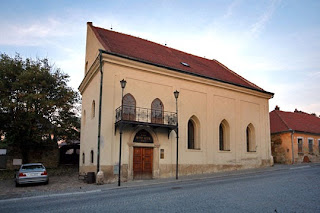Toronto was the northernmost destination on our synagogue
photo safari last summer. Well known as the home of the Maple Leafs hockey team,
a lesser known fact is its Jewish community numbers nearly 200,000, 14th
largest in the world. Back in the late 1800s and early 1900s, during the great
waves of Jewish immigration from Eastern Europe, Jews settled in Toronto’s
inner city. Usually poor and in need of social services, they turned to
landsmanshaften, mutual benefit societies, formed by other immigrants hailing
from the same shtetl.
In addition to the warmth of camaraderie from home, the
landsmanshaften provided social services, loans, job contacts and medical
assistance. And, they built synagogues. The three that we photographed were in Toronto’s
Kensington District, not more than 15 minutes walk from one another. Each was
established by immigrants who hailed from a particular European city. The three
are known as Da Minsker (The Minsk), The Kiever and The First Narayev.
Following the “birds of a feather” axiom, it’s better than even money that the
founding fathers (and mothers) were from Minsk, Kiev and Narayev.
 |
| The Kiever squeezed between trucks and cargo |
Our first photo-shoot appointment in Toronto was at The
Kiever, which fronts on a small and charming urban park surrounded by Victorian
era townhouses. It was so charming that a film crew working in the area had
parked one of their huge vans along with a great deal of equipment right in
front of The Kiever building. As a synagogue photographer, I hope for buildings
with visual interest and charm. But clearly, being too photogenic can create
competition for position and venue. I had to settle for some awkwardly squeezed
shots sighted between trucks and cargo.
This mission accomplished, we cooled off over lemonade and
corned beef sandwiches at a wonderful little outdoor restaurant right around
the corner. Taking a huge chocolate chip cookie to munch on, we walked through
a warren of narrow lanes for our photo-shoot appointment at Da Minsker. Our
path took us through the Kensington Market district, a maze of small shops,
many open to the street, manned by people of mostly Asian or Indian descent. In
a rich cacophony of foreign accents, they offered everything from exotic foods
to pedicures and rare books. 100 years earlier the voices and signs on these
buildings were Yiddish and the foods were for those of Ashkenazi immigrants
rather than organic foodies.
Rabbi Spero came bursting out of Da Minsker just as we
arrived. He explained that he had to hurry to give a bar mitzvah lesson but that
Joe, who we would find inside, would help with the photo-shoot. In a
congregation where almost all of the congregants are elderly, a bar mitzvah is
a rare and big deal. Sweating profusely, with tzi-tzis flying, the rabbi dashed
down the street to give the lesson, leaving us to find Joe.
 |
| Da Minsker in Toronto's Kensington Market District |
We resolved to wait a while for Right Joe. Through the dim
lighting I gazed with awe at the wonderful turn-of-the century sanctuary. Who
could imagine that such a humble exterior masked such a gorgeous interior? As I
studied the centrally located elevated wood bema, I noticed a man without a
shirt dive behind a chair in the women’s balcony. This was certainly odd. I
mentioned my sighting of the semi-clothed disappearing diver to WJ who was
still trying to pry open the electrical panel box. WJoe climbed the steep
winding stairs to the women’s balcony to investigate. Shortly, I heard someone
shout “Leave me alone!”
A few minutes later WJ appeared back in the vestibule with a
disheveled thirty-ish man who was buttoning his shirt. The shirt buttoner
introduced himself and explained that he was a would-be real estate developer (who
always wanted to be a Hollywood screenwriter/actor) who sometimes slept in the
synagogue to guard it because of security issues in the somewhat sketchy
neighborhood. The whole thing with semi-clothed women’s balcony mid-afternoon
naps seemed kind of questionable to me but WJ seemed at ease with Mr. Aspiring
Real Estate Developer. Better yet, the napper knew how to open the electrical
box to turn on the lights. He simply slammed it really hard with the palm of
his hand and the box flew open. With the lights on, the sanctuary’s old country
charm was fully revealed.
 |
| Sanctuary of Da Minsker |
Lights on and our access assured, WJ left for his weekly
pinochle game. Then, the sometimes shirted napper said that he had to leave for
30 minutes and would lock the building so that no unsavory characters could
enter while we were photographing. “Could we exit the building if we finish
before you return” I asked. No, the building would be fully locked without any
means of exit. Being a bit claustrophobic, I began worrying about what happens
if he doesn’t come back; it’s ninety degrees and stuffy in here; this old
building may be a fire-trap. There’s no way we’re staying locked up in an old
building in a rough part of Toronto dependent upon a person who does partially
disrobed napping in the women’s balcony to let us out when or if he comes back.
At times like these it really pays to have a smart, quick thinking wife. Before
he could leave, or even know what was happening, she turned on the charm, engaging
the now-shirted napper in conversation, barraging him with questions about his
work, life, Jewish geography, all sorts of stuff while I hurriedly took
photographs. As he poured out his life
story replete with unrequited loves, I focused and shot, focused and shot. Soon
I had my photos and she had his entire life story as well as curriculum vitae.
















